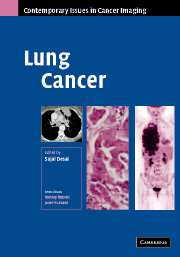Book contents
- Frontmatter
- Contents
- Contributors
- Series Foreword
- Introduction
- 1 Clinical Considerations in Lung Cancer
- 2 Pathology of Lung Cancer
- 3 Imaging of Lung Cancer
- 4 Screening for Lung Cancer
- 5 Staging of Lung Cancer
- 6 Positron Emmision Tomography in Lung Cancer
- 7 Contemporary Issues in the Systemic Treatment of Lung Cancer
- 8 Radiotherapy in Lung Cancer
- 9 Surgery for Lung Cancer
- Index
- Plate Section
- References
4 - Screening for Lung Cancer
Published online by Cambridge University Press: 12 August 2009
- Frontmatter
- Contents
- Contributors
- Series Foreword
- Introduction
- 1 Clinical Considerations in Lung Cancer
- 2 Pathology of Lung Cancer
- 3 Imaging of Lung Cancer
- 4 Screening for Lung Cancer
- 5 Staging of Lung Cancer
- 6 Positron Emmision Tomography in Lung Cancer
- 7 Contemporary Issues in the Systemic Treatment of Lung Cancer
- 8 Radiotherapy in Lung Cancer
- 9 Surgery for Lung Cancer
- Index
- Plate Section
- References
Summary
Introduction
To screen or not to screen? That is the question! The current debate continues. Compelling reasons for both optimism and doubt about the effectiveness of screening have been voiced in the literature and at medical conferences worldwide. The aim of this chapter will be to provide some background on lung cancer, the rationale for screening and the outcome of previous screening trials. It will also attempt to frame the debate regarding CT screening for lung cancer by presenting its potential benefits and potential risks. It will then be up to the reader to decide his or her own position about CT.
Background
Lung cancer is the most common fatal malignancy in the United States and deaths from lung cancer exceed the combined total of breast, colorectal and prostate carcinomas which are the three next most common causes of cancer deaths. It is estimated that 174,000 new cases and 160,000 deaths from lung cancer occurred in the United States in 2004. If mortality rates remain stable, over 1 million Americans will die of lung cancer in the next seven years. However, if there was an effective screening tool for lung cancer that resulted in a 10% mortality reduction an estimated 16,000 lives per year in the US could be saved. Breast, colorectal and prostate carcinomas all have relatively effective screening processes in place, which have demonstrated mortality reduction. It is these past successes for screening upon which the hope for lung cancer screening is founded.
- Type
- Chapter
- Information
- Lung Cancer , pp. 46 - 56Publisher: Cambridge University PressPrint publication year: 2006



